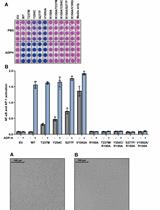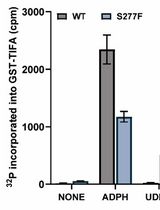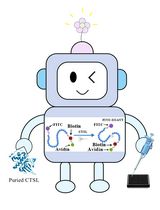- EN - English
- CN - 中文
Fluorescence HPLC Analysis of the in-vivo Activity of Glucosylceramide Synthase
葡糖基神经酰胺合酶体内活性的荧光HPLC检测
发布: 2019年06月20日第9卷第12期 DOI: 10.21769/BioProtoc.3269 浏览次数: 6565
评审: Neelanjan BoseIstvan StadlerAnonymous reviewer(s)
Abstract
Almost all functions of cells or organs rely on the activities of cellular enzymes. Indeed, the in-vivo activities that directly represent the cellular effects of enzymes in live organs are critical importance to appreciate the roles enzymes play in modulating physiological or pathological processes, although assessments of such in-vivo enzyme activity are more difficult than typical test-tube assays. Recently, we, for the first time, developed a direct and easy-handling method for HPLC analyzing the in-vivo activity of glucosylceramide synthase (GCS). GCS that converts ceramide into glucosylceramide is a limiting-enzyme in the syntheses of glycosphingolipids and is one cause of cancer drug resistance. In our method developed, rubusoside nanomicelles delivers fluorescence N-[6-[(7-nitro-2,1,3-benzoxadiazol-4-yl)amino]hexanoyl]-D-erythro-sphingosine (NBD C6-ceramide) into mice, tissues uptake the cell-permeable substrate, and GCS converts it into NBD C6-glucosylceramide in all organs simultaneously. Further, HPLC analyzes the extracted NBD C6-glucosylceramide to assess alterations of the in-vivo GCS activities in tissues. This method can be broadly used to assess the in-vivo GCS activities in any kind of animal models to appreciate either the role GCS plays in diseases or the therapeutic efficacies of GCS inhibitors.
Keywords: In-vivo enzyme activity (体内酶活性)Background
Glucosylceramide synthase (GCS; EC22.41.80; also known as ceramide glucosyltransferase) catalyzes ceramide glycosylation, transferring glucose residues from uridine diphosphate-glucose (UDP-glucose) to ceramide (Cer) and thereby producing glucosylceramide (GlcCer) (Basu et al., 1968; Ichikawa et al., 1996). Cer glycosylation by GCS is the first and rate-limiting step for the synthesis of glycosphingolipids (GSLs), over 400 species in human (Yu et al., 2009; Merrill, 2011; D'Angelo et al., 2013). Highly localized on GSL-enriched microdomains (GEMs) of cellular membranes, GSLs play crucial roles in modulating membrane integrity and functions, including cell-cell recognition, interaction and communication (Fishman and Brady, 1976; Yoshizaki et al., 2008; D'Angelo et al., 2013). GSLs are involved in mediating cell proliferation, differentiation, immuno-response and oncogenic transformation (Hakomori, 1981; Kasahara and Sanai, 2000; Hakomori, 2002).
Aberrant GCS or GSLs highly associate with several diseases. Recent studies concordantly indicate that enhanced GCS is one cause of cancer drug resistance (Liu et al., 2001, 2008, 2010 and 2013; Chiu et al., 2015; Roh et al., 2015). Further, inhibition of GCS, thereby decreasing GlcCer accumulation, is a treatment option for Gaucher’s disease (McEachern et al., 2007) and type II diabetes (Aerts et al., 2007; Zhao et al., 2007).
Quantitative assessment of GCS activity is essential for evaluating the roles Cer glycosylation playing in cell functions, as well as in therapeutic efficacies of relevant disease treatments. After Basu’s work (Basu et al., 1968), several additional methods have been developed to analyze GCS activities (Basu et al., 1987; Shukla and Radin, 1990; Ichikawa et al., 1996; Hayashi et al., 2005). Besides UDP-[3H]glucose being incorporated into ceramide to generate [3H]GlcCer (Shukla and Radin, 1990; Lavie et al., 1997; Liu et al., 1999), N-[6-[(7-nitro-2,1,3-benzoxadiazol-4-yl)amino]hexanoyl]-D-erythro-sphingosine (NBD C6-Cer) has been used as an acceptor to produce NBD C6-GlcCer by the prepared GCS protein in optimal in-vitro conditions (Ichikawa et al., 1996; Bourteele et al., 1998; Hayashi et al., 2005). The HPLC method based on NBD C6-Cer has proven to be a highly sensitive and reproducible assay for assessing GCS activity in-vitro assays (Ichikawa et al., 1996; Hayashi et al., 2005). Convergently, previous studies have shown that NBD C6-Cer can be used as an exogenous substrate for characterizing cellular Cer glycosylation and assessing GCS activities with thin-layer chromatography (TLC) and spectrometry (Gupta et al., 2010; Liu et al., 2010; Gupta et al., 2012). With nanoparticle-based delivery of NBD C6-Cer, we developed a rapid, efficient, and fully quantitative HPLC analysis for assessing GCS in-vivo activity in live mice (Khiste et al., 2017).
Rubusoside (RUB) has been used to improve solubility and consequently bioavailability of etoposide (Zhang et al., 2012). RUB based nanomicelles (Cer-RUB) significantly increases the aqueous solubility and bioavailability of NBD C6-Cer in vivo (Khiste et al., 2017). After intraperitoneal administration, almost all tissues efficiently uptake and use NBD C6-Cer as substrate for Cer glycosylation by GCS. Analysis of the extracted sphingolipids with HPLC allows us directly assess the in-vivo activities that GCS simultaneously conduct among tissues in live mice. This direct, specific and effective approach can be applied to measure intracellular and intra-organ GCS activities in live cells and tissues, enabling further assessments of the roles played by GCS in diseases. Notably, this methodology may have considerable value in predicting and monitoring therapeutic efficacy of various anticancer drugs, and of other therapeutic agents used in the treatments of GCS-related diseases.
Materials and Reagents
- Falcon 100 mm cell culture dish (Corning, catalog number: 353003)
- Dishes 35-mm (Corning, catalog number: 353001)
- Paper towels Scott C-fold (Uline, catalog number: 560801)
- BD 1 ml insulin syringes (Fisher Scientific, catalog number: 22-253-260)
- Pasteur pipettes (Fisher Scientific, catalog number: 13-678-20D)
- Microcentrifuge tubes, 1.5 ml (Fisher Scientific, catalog number: 0548129)
- Polypropylene centrifuge tubes, 15 ml (Fisher Scientific, catalog number: 22-010-076)
- Polypropylene centrifuge tubes, 50 ml (Fisher Scientific, catalog number: 05-539-6)
- Screw thread vials, glass 4 ml, amber (Thermo Fisher Scientific, catalog number: C4015-2W)
- Screw thread vials, glass 4 ml, transparent (Thermo Fisher Scientific, catalog number: C4015-21)
- LVITM (low volume insert) vials, 0.3 ml, amber glass (Wheaton, catalog number: 225328)
- 96-well black flat bottom polystyrene microplates for fluorescence measurement (Fisher Scientific, catalog number: 07-200-589)
- Polystyrene disposable pipets, 10 ml, sterile (Fisher Scientific, catalog number: NC9868325)
- Glass pipettes, 1 ml, sterile (Fisher Scientific, catalog number:12-724)
- Pipet tips, sterile, 200 μl and 1 ml (Fisher Scientific, catalog numbers: 02-707-502, 02-707-509)
- 0.45-μm nylon filter (Thermo Fisher Scientific, catalog number: 151-4045)
- Sterile alcohol prep pads (Dynarex, catalog number: 1114)
- Athymic nude mice (Foxn1nu/Foxn1+, 4-5 weeks, female from ENVOGO, catalog number: 069(nu)/070(nu/+))
- Human ovary cancer OVCAR-3 (ATCC, catalog number: ATCC® HTB-161TM) (Khiste et al., 2017)
- Mice carrying OVCAR-3 tumor xenografts and controls
- Inoculate OVCAR-3 cells (purchased from ATCC; ~3-5 passages, 1 x 106/20 μl per mouse) in serum-free medium subcutaneously inoculate into the left flanks of athymic nude mice (Foxn1nu/Foxn1+, 4-5 weeks, female; Harlan).
- In the control group, we only inoculate 20 μl serum-free medium. Once tumors sizes reach ~0.6 cm in diameters (~24 days), we will inject NBD Cer-RUB nanomicelles intraperitoneally in these mice for ceramide glycosylation.
- RPMI 1640 Medium (Thermo Fisher Scientific, catalog number: 11875-093), store at 4 °C
- Fetal bovine serum (FBS), heat inactivated (Thermo Fisher Scientific, catalog number: 10082147), store at -20 °C
- Phosphate buffer saline (PBS, 10x) (Thermo Fisher Scientific, catalog number: 70011-044), keeping at 4 °C for using
- NBD C6-ceramide (N-[6-[(7-nitro-2,1,3-benzoxadiazol-4-yl)amino]hexanol]-D-erythro-sphingosine) (Avanti Polar Lipids, catalog number: 810209), store at -20 °C
- NBD C6-glucosylceramide, (N-hexanoyl-NBD-glucosylceramide) (Matreya, catalog number: 1622-001)
- PierceTM BCA protein assay kit (Thermo Fisher Scientific, catalog number: 23227)
- Bovine serum albumin (BSA) (Sigma-Aldrich, catalog number: 9048-46-8), store at 4 °C
- NP40 Cell Lysis Buffer (Thermo Fisher Scientific, catalog number: FNN0021), store at -20 °C
- ProteaseArrestTM for Mammalian (G-Bioscience, catalog number: 786-433), store at 4 °C
- Methanol for HPLC, ≥ 99.9% (Sigma-Aldrich, catalog number: 67-56-1)
- Chloroform for HPLC, ≥ 99.5% (Sigma-Aldrich, catalog number: 67-66-3)
- Water for HPLC (Fisher Chemical, catalog number: 7732-18-5)
- Ortho-phosphoric acid for HPLC (Sigma-Aldrich, catalog number: 7664-38-2)
- Ethanol, anhydrous (Fisher Chemical, catalog number: A405-20)
- Rubusoside (RUB) (Sigma-Aldrich, catalog number: 62933-10MG)
- NBD C6-ceramide-rubusoside (NBD Cer-RUB) solution (see Recipes)
- NBD Cer-RUB nanomicelles (see Recipes)
- NP40 protein lysis solution (see Recipes)
- Solvent system for HPLC analysis (see Recipes)
Solvent A
Solvent B - NBD C6-ceramide or NBD C6-glucosylceramide standard solutions (see Recipes)
10 μM NBD C6-ceramide
10 μM NDB C6-glucosylceramide
Note: Store or keep all reagents at room temperature, except indicated items.
Equipment
- Pipette aids and pipette
- High precision microdissection scissors (Fisher Scientific, catalog number: 08-953-1B)
- Analytical balance (Mettler Toledo, catalog number: ME54TE/00)
- Freezer, -20 °C (Fisher Scientific, catalog number: 18LC-16WW-FS)
- Freezer, -80 °C (Thermo Scientific, catalog number: ULT1386-5-D41)
- Standard cell culture hood
- Vortex mixers (Fisher Scientific, catalog number: 02-215-360)
- HPLC system, Agilent 1220 Infinity II LC with Agilent 1260 fluorescence detector (Agilent Technologies)
- HPLC Colum, ZORBAX Rx-SIL 4.6 x 250 mm, 5 μM (Agilent Technologies, catalog number: 880975-901)
- Centrifuge (Eppendorf, model: 5804 R)
- Centrifuge (Eppendorf, model: 5424 R)
- Water bath and incubator
- Reacti-Vap evaporators (Thermo Fisher Scientific, catalog number: TS-18826)
- Ultrasonic processor (Fisher Scientific, model: CPX130PB)
- Microplate Reader (BioTek, Synergy HTX multi-mode reader)
Software
- Prism 5v for statistical analysis (GraphPad Software Inc.)
- Agilent OpenLab CDS (EZChrom edition, version A.04.05) for HPLC analysis
Procedure
文章信息
版权信息
© 2019 The Authors; exclusive licensee Bio-protocol LLC.
如何引用
Roy, K. R., Khiste, S. K., Liu, Z. and Liu, Y. (2019). Fluorescence HPLC Analysis of the in-vivo Activity of Glucosylceramide Synthase. Bio-protocol 9(12): e3269. DOI: 10.21769/BioProtoc.3269.
分类
癌症生物学 > 癌症生物化学 > 耐药性
细胞生物学 > 细胞新陈代谢 > 脂质
生物化学 > 蛋白质 > 活性
您对这篇实验方法有问题吗?
在此处发布您的问题,我们将邀请本文作者来回答。同时,我们会将您的问题发布到Bio-protocol Exchange,以便寻求社区成员的帮助。
Share
Bluesky
X
Copy link














